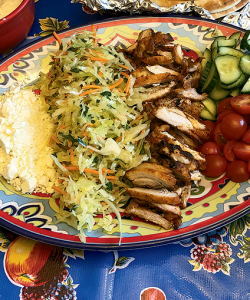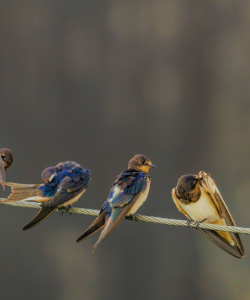The Written Image: Home Cooking

Writers have been cooking up a bright array of foods, from strawberry chiffon cake to Sichuan chili fish, while heeding orders to stay at home during the pandemic.
Jump to navigation Skip to content

Writers have been cooking up a bright array of foods, from strawberry chiffon cake to Sichuan chili fish, while heeding orders to stay at home during the pandemic.
This behind-the-scenes short film directed by Yvonne Shirley of a 2018 T Magazine photo shoot at the Brooklyn Historical Society features Black American male poets, playwrights, and novelists—such as James Hannaham, Yusef Komunyakaa, and Ishmael Reed—speaking on identity in the publishing world and paying tribute to their favorite Black female writers.
Submissions are open for the 2020 Richard J. Margolis Award. Established in the memory of journalist, essayist, and poet Richard J. Margolis, the annual prize awards $5,000 and a one-month residency at Blue Mountain Center in Blue Mountain Lake, New York, to a journalist or essayist whose work “combines warmth, humor, and wisdom and sheds light on issues of social justice.”
Submit a cover letter, a project description that includes details of current and anticipated work, a short bio, and two to three writing samples totaling no more than thirty pages by July 1. There is no entry fee. The winner will be announced in November, with the Blue Mountain Center residency to take place in summer or fall 2021. Visit the website for complete guidelines.
Over the course of his career, Richard J. Margolis worked as a writer, educator, editor, and activist. He wrote widely on education, healthcare, poverty, rural America, and racial justice, among other topics, and his articles appeared regularly in such publications as the New York Times and Washington Post. His friends and family founded the Richard J. Margolis Award in 1992, a year after he died due to sudden heart failure at age sixty-one. The award’s most recent winner is memoirist Mansoor Adayfi, who received the honor for work that turns his “fourteen-plus years of captivity at Guantánamo Bay Prison Camp into compelling narratives of human connection and hope.”
Conceptual artist Christo, who died on Sunday, was known for his large-scale environmental pieces mostly created in partnership with his wife Jeanne-Claude and involving the cooperation of many others—including politicians, legal workers, landowners, environmental groups, engineers, and city administrators—and often taking decades to complete. In a 1972 New York Times article, Christo said: “For me esthetics is everything involved in the process—the workers, the politics, the negotiations, the construction difficulty, the dealings with hundreds of people. The whole process becomes an esthetic—that’s what I’m interested in, discovering the process. I put myself in dialogue with other people.” Find a personal essay you wrote in the past, or perhaps one you never finished, and work on adding a new layer that incorporates all of the people and things that have to be in place for you to do your creative work. You might include documents, photographs, found text, or other ephemera in your piece.

The author of This Is One Way to Dance reflects on using fragments to build a larger structure.
In Tracy O’Neill’s new novel, Quotients (Soho Press, 2020), one character says to another: “When the luck is good, the answer is not why. It is yes.” Over the years countless authors—and their characters—have shared a range of perspectives on the notion of luck, many of them leaning toward skepticism or wariness. Emily Dickinson wrote: “Luck is not chance— / It’s Toil— / Fortune’s expensive smile / Is earned.” In No Country for Old Men, Cormac McCarthy wrote: “You never know what worse luck your bad luck has saved you from.” And in The Old Man and the Sea, Ernest Hemingway wrote: “It is better to be lucky. But I would rather be exact. Then when luck comes you are ready.” Write a personal essay about a time when you experienced a stroke of luck, good or bad. Has the significance of luck in your life changed over time?
“Books have been such an important part of my life, from The Brothers Karamazov when I was a teenager to reading Charlotte’s Web to my grandchildren,” says Hillary Clinton in this video of over one hundred book-loving authors, actors, musicians, public figures, and professional librarians sharing their favorite books in celebration of the New York Public Library’s 125th anniversary.
“I reached toward the mask, toward my friend, trying to keep away from her at the same time—both of us a little bit nervous, a little bit scared (I’ve never before noticed that “scared” and “sacred” are so close),” writes Ross Gay in “The Joy of Caring for Others,” one of fourteen New York Times pieces in which writers describe what is currently bringing them joy. In the series, Aminatou Sow writes about “The Joy of Perfecting the Sexy Selfie,” Max Read writes about “The Joy of Consuming an Obscene Number of Calories Before Noon,” and Jenna Wortham writes about “The Joy of Regrowing My Scallions—Yes, Regrowing My Scallions.” Write your own “Joy of…” essay, zeroing in on joy found in unexpectedly mundane or previously suspect corners. What is simple and what is complex about this pleasure?

The author of This Is One Way to Dance shares how notes—footnotes, codas, prologues, corrections—figure into her writing process.
In this installment of the AAWW at Home series, Rowan Hisayo Buchanan, author of the novel Starling Days (Overlook Press, 2020), talks about how she’s been occupied during the coronavirus pandemic lockdown and reads from Alexander Chee’s essay collection, How to Write an Autobiographical Novel (Mariner Books, 2018).